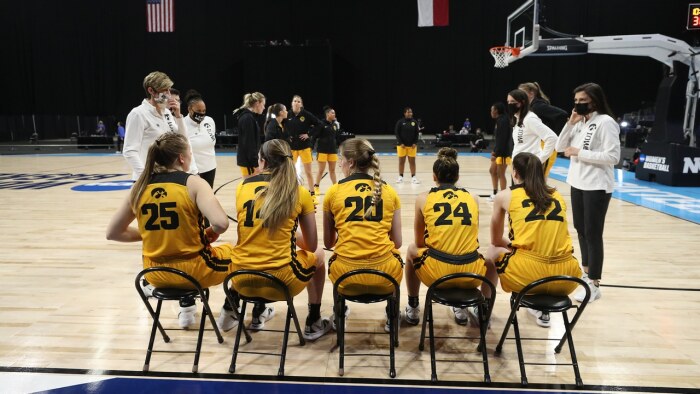Ira Lacher: It’s long past time for women’s college sports to again be governed by an organization committed to promoting women’s college sports. -promoted by Laura Belin
Anyone who tuned in on Saturday, March 27, to watch the University of Iowa take on top-seeded Connecticut in the women’s NCAA college basketball tournament should have been made aware of how poorly the NCAA has treated the women’s game.
Since the tournament in San Antonio, Texas, began, articles have repeatedly evidenced the utter inequality between it and the men’s tournament, in Indianapolis. Optics that include no on-site TV commentators until the round of 16, the dearth of marketing presence around the Texas city, inadequate weight rooms, the outright ban on the term “March Madness” for the women’s tournament, and the investment disparity, prove more than ever that the NCAA’s treatment of women’s sports is how W. C. Fields deals with annoyances: “Go on, kid, ya bother me.”
“This is an issue of fairness,” Amy Privette Perko, chief executive of the Knight Commission on Intercollegiate Athletics, asserted in The New York Times. “The NCAA is intended to be a unifying organization for its schools to provide educational opportunities through sports. One of its foundational principles is to conduct its activities in a ‘manner free of gender bias,’ and in this case, it seems clear that the NCAA failed to meet its own standard.”
But there’s a simple make-good for this separate-but-unequal treatment: Let college women’s sports once again be administered by an organization that has a herstory of keeping the toilet seat down: the Association of Intercollegiate Athletics for Women (AIAW).
During the dark ages of the Sixties and Seventies, before Title IX, the NCAA refused to admit that women played intercollegiate sports that attracted capable athletes and dedicated fans. But beginning in 1971, the AIAW, which replaced the feeble Commission on Intercollegiate Athletics for Women, enlisted ultimately nearly a thousand member schools, sponsoring national championships in 17 sports. My alma mater, Queens College of the City University of New York, a member of AIAW Division I, not only played for a national basketball title in 1972 but also competed in the first women’s basketball game, college or pro, played at Madison Square Garden in 1975, before a crowd of 12,000.
Unlike the NCAA, which gobbledygooked the term “student athlete” to shelter its member schools from having to pay workers compensation, the AIAW from the outset truly was a league for student athletes. “The AIWA focused on the female student-athlete’s education, not on athletic performance, and thus rejected the ‘win or die’ attitude of the NCAA,” Dr. Richard Bell wrote in The Sport Journal. “Instead, the AIAW emphasized participation in sport as the most important aspect and de-emphasized winning.”
Mostly, the AIAW spurred schools to unprecedented investments in women’s sports. “Dollars invested [in women’s athletics] grew from virtually zero in 1971 to more than $100 million by 1982,” Ann Uhlir wrote in The New York Times. “Financial aid awarded to female athletes in the 960 AIAW member institutions exceeded $30 million in 1980-81.”
Those numbers woke the NCAA — to realizing they were ignoring free money. So, like a vengeful jilted bridegroom, they forced the AIAW out of control of women’s sports by bribing schools to jump to the NCAA: offering to pay all tourney participation expenses, extending financial aid, and promising TV coverage, which was nonexistent.
“The … organization that sought to dilute the impact of Title IX, the NCAA, had in three short years devastated the AIAW,” Uhlir wrote in what amounted to its obituary. The organization ceased operations June 30, 1982.
Since then, the NCAA has treated women’s sports, particularly basketball, as little more than a trophy wife, even attempting to overturn the Title IX legislation that forced it to accept women’s sports in the first place. And “equality”? Never part of its commitment. “The NCAA, the non-profit that should be bending over backwards to correct the media on its mistakes, among many other inequities, has instead been actively engaging in misogyny for decades,” Christine Brennan wrote recently in USA Today.
Of course the NCAA certainly is gender-equal — in exploiting young men and women, denying them even a pittance for all the billions of dollars in revenue they earn for their schools and the organization itself. But the sun is setting on that empire. California has mandated payment for some student athletes; other states are sure to follow. And it won’t be long before the NCAA is forced to capitulate, paying male athletes but, it can be safely predicted, paying female athletes less. Which will invite additional legal action.
But there’s an easier way than maintaining a rocky estrangement: an amicable divorce.
Perhaps a few power women’s coaches, such as Iowa’s Lisa Bluder, Stanford’s Tara VanDerveer, and Notre Dame’s Muffet McGraw, could get together with a few power moguls, such as Jeff Bezos, Bill Gates, George Soros, and Mark Zuckerberg, and persuade them to revive the AIAW? Yeah, it would take a couple of billion dollars, but that’s chump change for those folks, collectively valued at nearly a quarter of a trillion. And what better way to convince hostile lawmakers you’re really good, woke guys so as to distract them from breaking up your monopolies?
With the #MeToo movement having arrived at the NCAA’s center circle, it’s long past time for women’s college sports to again be governed by an organization committed to promoting women’s college sports. Women’s athletics and the NCAA have been in an abusive relationship for more than 30 years. It’s time for a divorce.
Top image: Coach Lisa Bluder and members of the University of Iowa women’s basketball team at the 2021 NCAA tournament. Photo by HawkeyeSports.com posted on the Iowa women’s basketball Twitter feed.

